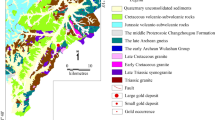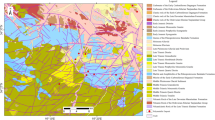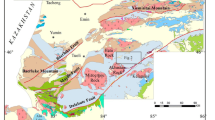Abstract
Distance anomaly factors (DAFs) were defined for each cell of the unit cell population in a study area to represent mineral potential of the cell. A DAF of a cell is a formula for the total distance from the cell to all other cells in the study area. The distance between two cells can be expressed as the Manhattan distance, Canberra distance, Euclidean distance, and kernel Euclidean distance. The kernels in the kernel Euclidean distance can be radial basis function (RBF) kernel, chi-squared kernel, sigmoid kernel, Laplacian kernel, and polynomial kernel. Accordingly, eight DAFs were defined to map gold potential of the Jinchanggouliang area, Inner Mongolia, China. The receiver operating characteristic (ROC) curve analysis was used to evaluate the effectiveness of the eight DAFs. The results show that these DAFs are comparable to one-class support vector machine (OCSVM) in gold potential mapping. The optimal threshold for distinguishing gold potential cells from all the cells was determined by maximizing the Youden index. The gold potential targets predicted by the eight DAFs occupy 7.4% – 16.5% of the study area, while containing 78% - 91% of the discovered gold deposits. The gold potential targets predicted by the default parameter OCSVM and by the bat-optimized OCSVM occupy 9.4% and 16.4% of the study area, respectively, while containing 78% and 87% of the discovered gold deposits. Therefore, the eight DAFs are feasible approaches for gold potential mapping. Their effectiveness needs to be further tested in mineral potential mapping in other areas.





Similar content being viewed by others
References
Beals WE (1984) Bray-Curtis ordination: An effective strategy for analysis of multivariate ecological data. Adv Ecol Res 14:1–55
Bonham-Carter GF, Agterberg FP, Wright DF (1988) Integration of geological datasets for gold exploration in Nova Scotia. Photogramm Eng Remote Sens 54(11):1585–1592
Carranza EJM, Hale M (2001) Logistic regression for geologically constrained mapping of gold potential, Baguio district, Philippines. Explor Min Geol 10(3):165–175
Carranza EJM, Hale M (2002) Where are porphyry copper deposits spatially localized? A case study in Benguet province, Philippines. Nat Resour Res 11(1):45–59
Carranza EJM, Laborte AG (2015) Random forest predictive modeling of mineral prospectivity with small number of prospects and data with missing values in Abra (Philippines). Comput Geosci 74(1):60–70
Chen YL (2015) Mineral potential mapping with a restricted Boltzmann machine. Ore Geol Rev 71:749–760
Chen YL, Li XB (2010) Kernel-based hierarchical cluster analysis. J Jilin Univ (Earth Sci Ed) 40(5):1211–1216 (In Chinese with English Abstract)
Chen YL, Lu LJ, Li XB (2014) Kernel Mahalanobis distance for multivariate geochemical anomaly recognition. J Jilin Univ (Earth Sci Ed) 44(1):396–408 (In Chinese with English Abstract)
Chen YL, Wu W (2016) A prospecting cost-benefit strategy for mineral potential mapping based on ROC curve analysis. Ore Geol Rev 74:26–38
Chen YL, Wu W (2017a) Mapping mineral prospectivity using an extreme learning machine regression. Ore Geol Rev 80:200–213
Chen YL, Wu W (2017b) Mapping mineral prospectivity by using one class support vector machine to identify multivariate geological anomalies from digital geological survey. Aust J Earth Sci 44(5):639–651
Chen YL, Wu W (2017c) Application of one-class support vector machine to quickly identify multivariate anomalies from geochemical exploration data. Geochemistry: Exploration, Environment, Analysis 17:231–238
Chen YL, Wu W (2019) Isolation forest as an alternative data-driven mineral prospectivity mapping method with a higher data-processing efficiency. Nat Resour Res 28(1):31–46
Chen YL, Wu W, Zhao QY (2019) A bat-optimized one-class support vector machine for mineral prospectivity mapping. Mineral 9(317):1–23
Chu JS, Jia HJ (2000) Geological characteristics and genesis of the Jinchangguoliang gold deposit. Mineral Resources Geol 14(3):155–157 (In Chinese with English Abstract)
Dalfó C, Comellas F, Fiol AM (2007) The multidimensional Manhattan network. Electron Notes Discrete Math 29:383–387
Duan PX, Li CM, Liu C, Deng JF, Zhao GC (2014) Geochronology and geochemistry of the granites from the Jinchanggouliang gold deposit area in the Inner Mongolia and its geological significance. Acta Petrol Sin 30(11):3189–3202 (In Chinese with English Abstract)
Ford A, Miller JM, Mol AG (2015) A comparative analysis of weights of evidence, evidential belief functions, and fuzzy logic for mineral potential mapping using incomplete data at the scale of investigation. Nat Resour Res 25(1):19–33
Fu LB (2012) The Mesozoic tectonic-magmatic evolution process and gold metallogenesis in the Chifeng-Chaoyang region, Northern North China Craton. Doctoral Thesis, China University of Geosciences, Wuhan, China (In Chinese with English Abstract)
Fu LB, Wei JH, Kusky MT, Chen HY, Tan J, Li YJ, Shi WJ, Chen C, Zhao SQ (2012) The cretaceous Duimiangou adakite-like intrusion from the Chifeng region, northern North China Craton: crustal contamination of basaltic magma in an intracontinental extensional environment. Lithos 134-135:273–288
Goyal S, Patterh MS (2013) Wireless sensor network localization based on bat algorithm. Int J Emerging Technol Comput Appl Sci (IJETCAS) 4(5):507–512
Kocher M, Savoy J (2017) Distance measures in author profiling. Inf Process Manag 53:1103–1119
Li F, Chen M, Liu XY (2016) Geological characteristics and metallogenic regularity of gold deposits in the Aohan banner, Inner Mongolia, China. Geol Prospect 24(4):152–155 (In Chinese with English Abstract)
Li S, Chen JP, Xiang J (2020) Applications of deep convolutional neural networks in prospecting prediction based on two-dimensional geological big data. Neural Comput & Applic 32:2037–2053
Li T, Zuo RG, Xiong YH, Peng Y (2021) Random-drop data augmentation of deep convolutional neural network for mineral prospectivity mapping. Nat Resour Res 30:27–38
Miao LC, Fan WM, Zhai MG, Qiu YM, McNaughton NJ, Groves DI (2003) Zircon SHRIMP U-Pb geochronology of the granitoid intrusions from Jinchanggouliang-Erdaogou gold orefield and its significance. Acta Petrol Sin 19(1):71–80 (In Chinese with English Abstract)
Poli R, Kennedy J, Blackwell T (2007) Particle swarm optimization-an overview. Swarm Intelligence 1(1):33–57
Schӧlkopf B, Platt J, Shawe-Taylor J, Smola A, Williamson R (2001) Estimating the support of a high-dimensional distribution. Neural Comput 13:1443–1471
Sharawi M, Emary E, Saroit IA, El-Mahdy H (2012) Bat swarm algorithm for wireless sensor networks lifetime optimization. Int J Sci Res (IJSR) 3(5):655–664
Shieh MZ, Tsai SC (2012) Computing the ball size of frequency permutations under Chebyshev distance. Linear Algebra Appl 437:324–332
Sun ZJ (2013) Study on gold deposits mineralization in the Chifeng-Chaoyang region, the northern margin of North China Craton. Doctoral Thesis, Jilin University, Changchun (In Chinese with English Abstract)
Sun ZJ, Li XY, Yu HN, Sun GS, Zhu JH, Lu LN, Xue HY, Su R (2014) Characteristics of ore-forming fluid and stable isotope from the Jinchanggouliang gold deposit in Inner Mongolia, China. Global Geology 33(3):591–602 (In Chinese with English Abstract)
Wang G (2015) Geochemical characteristics and genetic mechanism of the Jinchangliang gold deposit in the Aohan banner, Inner Mongolia, China. Master Thesis, Jilin University, Changchun (In Chinese with English Abstract)
Xia SY, Xiong ZY, Luo YG, Xu W, Zhang GH (2015) Effectiveness of the Euclidean distance in high dimensional spaces. Optik 126:5614–5619
Xiong YH, Zuo RG (2017) Effects of misclassification costs on mapping mineral prospectivity. Ore Geol Rev 82:1–9
Xiong YH, Zuo RG, Carranza EJM (2018) Mapping mineral prospectivity through big data analytics and a deep learning algorithm. Ore Geol Rev 102:811–817
Yang XS (2010) A new metaheuristic bat-inspired algorithm. In: González JR, Pelta DA, Cruz C, Terrazas G, Krasnogor N (eds) Proceedings of nature inspired cooperative strategies for optimization (NICSO 2010), Granada, Spain, 12-14 may 2010. Springer, Berlin, pp 65–74
Yang XS, Gandomi AH (2012) Bat algorithm: a novel approach for global engineering optimization. Eng Comput 29(5):464–483
Yang XS, Karamanoglu M, Fong S (2012) Bat algorithm for topology optimization in microelectronic applications. In: Proceedings of the First International Conference on Future Generation Communication Technologies, London, UK, 12–14 December 2012. IEEE press, pp 150–155
Zhang CC, Wang SQ, Zhang T (2002) Stable isotope characteristics of the Jinchanggouliang gold deposit in Inner Mongolia and its origin. J Geom 8(2):156–164 (In Chinese with English Abstract)
Zhang J, Marszalek M, Lazebnik S, Schmid C (2007) Local features and kernels for classification of texture and object categories: a comprehensive study. Int J Comput Vis 73(2):213–238
Zhang WB, Hou WR, Nie FJ, Cao Y, Wang FX, Ding CW (2014) Geological features and metallogenic time of the Jinchanggouliang gold deposit, Aohan banner, Inner Mongolia. Geological Rev 60(6):1409–1417 (In Chinese with English Abstract)
Zuo RG, Carranza EJM (2011) Support vector machine: a tool for mapping mineral potential. Comput Geosci 37(12):1967–1975
Zuo RG, Wang ZY (2020) Effects of random negative training samples on mineral prospectivity mapping. Nat Resour Res 29:3443–3455
Acknowledgments
This study was supported by National Natural Science Foundation of China (Grant nos. 41672322 and 41872244).
Author information
Authors and Affiliations
Corresponding authors
Additional information
Communicated by: H. Babaie
Publisher’s note
Springer Nature remains neutral with regard to jurisdictional claims in published maps and institutional affiliations.
Rights and permissions
About this article
Cite this article
Chen, Y., Sun, G. & Zhao, Q. Distance anomaly factors for gold potential mapping in the Jinchanggouliang area, Inner Mongolia, China. Earth Sci Inform 14, 1083–1099 (2021). https://doi.org/10.1007/s12145-021-00614-5
Received:
Accepted:
Published:
Issue Date:
DOI: https://doi.org/10.1007/s12145-021-00614-5




